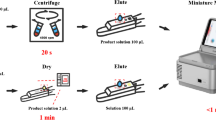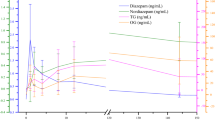Abstract
Since the late 1990s and early 2000s, derivatives of well-known designer drugs as well as new psychoactive compounds have been sold on the illicit drug market and have led to intoxications and fatalities. The LC-MS/MS screening method presented covers 31 new designer drugs as well as cathinone, methcathinone, phencyclidine, and ketamine which were included to complete the screening spectrum. All but the last two are modified molecular structures of amphetamine, tryptamine, or piperazine. Among the amphetamine derivatives are cathinone, methcathinone, 3,4-DMA, 2,5-DMA, DOB, DOET, DOM, ethylamphetamine, MDDMA, 4-MTA, PMA, PMMA, 3,4,5-TMA, TMA-6 and members of the 2C group: 2C-B, 2C-D, 2C-H, 2C-I, 2C-P, 2C-T-2, 2C-T-4, and 2C-T-7. AMT, DPT, DiPT, MiPT, DMT, and 5MeO-DMT are contained in the tryptamine group, BZP, MDBP, TFMPP, mCPP, and MeOPP in the piperazine group. Using an Applied Biosystems LC-MS/MS API 365 TurboIonSpray it is possible to identify all 35 substances. After addition of internal standards and mixed-mode solid-phase extraction the analytes are separated using a Synergi Polar RP column and gradient elution with 1 mM ammonium formate and methanol/0.1% formic acid as mobile phases A and B. Data acquisition is performed in MRM mode with positive electro spray ionization. The assay is selective for all tested substances. Limits of detection were determined by analyzing S/N-ratios and are between 1.0 and 5.0 ng/mL. Matrix effects lie between 65% and 118%, extraction efficiencies range from 72% to 90%.





Similar content being viewed by others
References
2009, World Drug Report 2008, United Nations, Office on Drugs and Crime
2009, Drogen- und Suchtbericht 2008, Bundesministerium für Gesundheit
Kovaleva J, Devuyst E, De Paepe P, Verstraete A (2008) Acute chlorophenylpiperazine overdose: a case report and review of the literature. Ther Drug Monit 30:394–398
Miyajima M, Matsumoto T, Ito S (2008) 2C-T-4 intoxication: acute psychosis caused by a designer drug. Psychiatry Clin Neurosci 62:243
Elliott S, Smith C (2008) Investigation of the first deaths in the United Kingdom involving the detection and quantitation of the piperazines BZP and 3-TFMPP. J Anal Toxicol 32:172–177
Tanaka E, Kamata T, Katagi M, Tsuchihashi H, Honda K (2006) A fatal poisoning with 5-methoxy-N, N-diisopropyltryptamine, Foxy. Forensic Sci Int 163:152–154
Balikova M (2005) Nonfatal and fatal DOB (2, 5-dimethoxy-4-bromoamphetamine) overdose. Forensic Sci Int 153:85–91
Wilson JM, McGeorge F, Smolinske S, Meatherall R (2005) A foxy intoxication. Forensic Sci Int 148:31–36
Ling LH, Marchant C, Buckley NA, Prior M, Irvine RJ (2001) Poisoning with the recreational drug paramethoxyamphetamine (“death”). Med J Aust 174:453–455
Elliott SP (2000) Fatal poisoning with a new phenylethylamine: 4-methylthioamphetamine (4-MTA). J Anal Toxicol 24:85–89
Felgate HE, Felgate PD, James RA, Sims DN, Vozzo DC (1998) Recent paramethoxyamphetamine deaths. J Anal Toxicol 22:169–172
James RA, Dinan A (1998) Hyperpyrexia associated with fatal paramethoxyamphetamine (PMA) abuse. Med Sci Law 38:83–85
Boatto G, Nieddu M, Carta A, Pau A, Palomba M, Asproni B, Cerri R (2005) Determination of amphetamine-derived designer drugs in human urine by SPE extraction and capillary electrophoresis with mass spectrometry detection. J Chromatogr B Analyt Technol Biomed Life Sci 814:93–98
Boatto G, Nieddu M, Dessi G, Manconi P, Cerri R (2007) Determination of four thiophenethylamine designer drugs (2C-T-series) in human plasma by capillary electrophoresis with mass spectrometry detection. J Chromatogr A 1159:198–202
Boatto G, Nieddu M, Pirisi MA, Dessi G (2007) Simultaneous determination of new thioamphetamine designer drugs in plasma by capillary electrophoresis coupled with mass spectrometry. Rapid Commun Mass Spectrom 21:3716–3720
Nieddu M, Boatto G, Dessi G (2007) Determination of 4-alkyl 2, 5 dimethoxy-amphetamine derivatives by capillary electrophoresis with mass spectrometry detection from urine samples. J Chromatogr B Analyt Technol Biomed Life Sci 852:578–581
Nieddu M, Boatto G, Carta A, Sanna A, Pisano M (2005) Simultaneous determination of ten amphetamine designer drugs in human whole blood by capillary electrophoresis with diode array detection. Biomed Chromatogr 19:737–742
Nieddu M, Boatto G, Pirisi MA, Azara E, Marchetti M (2008) LC-MS analysis of trimethoxyamphetamine designer drugs (TMA series) from urine samples. J Chromatogr B Analyt Technol Biomed Life Sci 867:126–130
Peters FT, Schaefer S, Staack RF, Kraemer T, Maurer HH (2003) Screening for and validated quantification of amphetamines and of amphetamine- and piperazine-derived designer drugs in human blood plasma by gas chromatography/mass spectrometry. J Mass Spectrom 38:659–676
Pichini S, Pujadas M, Marchei E, Pellegrini M, Fiz J, Pacifici R, Zuccaro P, Farre M, de la Torre R (2008) Liquid chromatography-atmospheric pressure ionization electrospray mass spectrometry determination of "hallucinogenic designer drugs" in urine of consumers. J Pharm Biomed Anal 47:335–342
Nordgren HK, Holmgren P, Liljeberg P, Eriksson N, Beck O (2005) Application of direct urine LC-MS-MS analysis for screening of novel substances in drug abusers. J Anal Toxicol 29:234–239
Vorce SP, Sklerov JH (2004) A general screening and confirmation approach to the analysis of designer tryptamines and phenethylamines in blood and urine using GC-EI-MS and HPLC-electrospray-MS. J Anal Toxicol 28:407–410
Nordgren HK, Beck O (2004) Multicomponent screening for drugs of abuse: direct analysis of urine by LC-MS-MS. Ther Drug Monit 26:90–97
Ishida T, Kudo K, Inoue H, Tsuji A, Kojima T, Ikeda N (2006) Rapid screening for and simultaneous semiquantitative analysis of thirty abused drugs in human urine samples using gas chromatography-mass spectrometry. J Anal Toxicol 30:468–477
Matuszewski BK, Constanzer ML, Chavez-Eng CM (2003) Strategies for the assessment of matrix effect in quantitative bioanalytical methods based on HPLC-MS/MS. Anal Chem 75:3019–3030
Dresen S, Kempf J, Weinmann W (2006) Electrospray-ionization MS/MS library of drugs as database for method development and drug identification. Forensic Sci Int 161:86–91
Weinmann W (2009) ChemicalSoft, designer drugs product ion spectra API 365 (2009), www.chemicalsoft.de/designerdrugs2009/MSMS_API-DD-index.php
Commission E (2002) 2002/657/EC: Commission Decision of 12 August 2002 implementing Council Directive 96/23/EC concerning the performance of analytical methods and the interpretation of results
Curtis B, Kemp P, Harty L, Choi C, Christensen D (2003) Postmortem identification and quantitation of 2, 5-dimethoxy-4-n-propylthiophenethylamine using GC-MSD and GC-NPD. J Anal Toxicol 27:493–498
Habrdova V, Peters FT, Theobald DS, and Maurer HH (2005) Screening for and validated quantification of phenethylamine-type designer drugs and mescaline in human blood plasma by gas chromatography/mass spectrometry. J Mass Spectrom 40:785–795
Acknowledgments
The authors like to thank Dr Sylvia Brunet Perez of the Landeskriminalamt Hamburg for providing compounds and the “Bund gegen Alkohol und Drogen im Straßenverkehr e.V.” for financial support of the project.
Author information
Authors and Affiliations
Corresponding author
Rights and permissions
About this article
Cite this article
Wohlfarth, A., Weinmann, W. & Dresen, S. LC-MS/MS screening method for designer amphetamines, tryptamines, and piperazines in serum. Anal Bioanal Chem 396, 2403–2414 (2010). https://doi.org/10.1007/s00216-009-3394-4
Received:
Revised:
Accepted:
Published:
Issue Date:
DOI: https://doi.org/10.1007/s00216-009-3394-4




